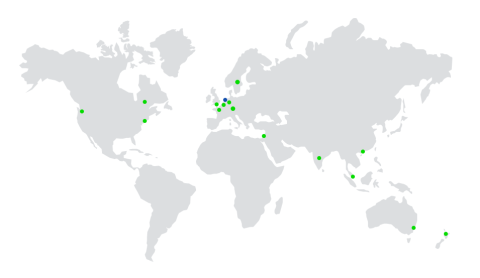
What is Planned Preventative Maintenance (PPM)?
Planned Preventive Maintenance is a form of maintenance that does not wait for an asset to wear out or fail, but it is replaced before it reaches end-of-life. This can be either time or condition-based.
Planned Preventive Maintenance is a vast improvement over the reactive maintenance model that many organizations used to rely on. In reactive maintenance one essentially ignores the fact that all assets have a maximum lifespan.
Moreover, when relying on reactive maintenance, something always breaks down when it's not convenient for you, and – entirely according to Murphy's Law – there are no spare parts available.
By implementing planned preventive maintenance, organizations can significantly reduce their reactive maintenance costs and keep their buildings and assets at the desired quality level.
As mentioned in the introduction, Planned Preventative Maintenance can be either time-based or condition-based.
Time-based preventive maintenance is based on a fixed execution frequency of activities that generates a calendar schedule. A time-based maintenance plan for an asset is based on a library with maintenance activities and their preset frequency of execution for that asset.
These frequencies can be based on warranties, supplier instructions, legislation, or experience. For example, time-based maintenance would allow you to schedule the yearly inspection of your airconditioner, along with its filter cleanings three times a year, and its filter replacement six times a year.
However, time-based maintenance might be too late, causing reactive maintenance, since the actual condition of the asset is not considered. On the other hand, time-based maintenance might suggest an action too early, especially if the asset is in better condition than expected.
Condition monitored preventive maintenance aims to predict when an asset might fail and prevent it from doing so by performing the right maintenance. Condition monitored maintenance applies to assets that can communicate their actual status in real-time to your maintenance system (IWMS, CAFM, CMMS), where threshold values and preset parameters forecast the type and timing of maintenance. This monitoring allows for just-in-time maintenance that minimizes costs and prevents asset failure and the resulting reactive maintenance.
An example of condition monitored maintenance is a preset threshold for your heating installation. When the temperature of the installation exceeds this threshold value, a preventive maintenance activity is generated to avoid failure. A second example is when operating hours exceed a preset value, the next maintenance activity is automatically scheduled at the right time.
Learn more about planned preventive maintenance

Planon Asset & Maintenance Management
Planon’s Asset & Maintenance Management solution minimizes asset downtime and disruption by managing the entire lifecycle, from start of use, to ongoing management, to removal or sale of asset.
Read more
Planon Mobile Field Services
Planon’s Mobile Field Services Solution helps you meet challenges by rapidly and securely providing your field service team with solutions they can use on iOS and Android devices. Request a demo now!
Request now
8 FAQ's about mobile solutions and automation for improved maintenance operations
Many organizations are looking to invest in technology to improve their maintenance operations. Top reasons include reducing operational costs, reducing risk, improving record keeping, and improving maintenance scheduling.
Read moreBenefits and applications of time-based maintenance
Planning is the biggest advantage of any preventive maintenance, compared to nonexistant planning with reactive maintenance. Reactive maintenance has many overhead costs that can be avoided during the planning process. The costs of unplanned maintenance include those of lost production, downtimes, higher costs for parts, and time lost in responding.
Market benchmarks indicate that unplanned maintenance typically costs three to five times more than when initially planned. However, when maintenance is planned, equipment can be shut down outside production hours to minimize business impacts, and any required parts and staff can be gathered prior to the shutdown to minimize the work execution time. In addition to cost reduction, business continuity is also improved with planned preventive maintenance, as assets break down less often.
Compared to condition-monitored maintenance, time-based maintenance does not require a specific monitoring strategy, eliminating the need to interpret the actual condition data and act accordingly. However, as previously stated, maintenance may occur either too often or not often enough with a time-based strategy.
Suitable assets for time-based preventive maintenance include those that have a critical operational function, have preventable failure modes, and that have an increasing likelihood of failure over time.
Benefits and applications of condition monitored maintenance
Condition monitored maintenance, also known as predictive maintenance, aims to predict when asset failure might occur and when maintenance is needed. The goal is to prevent failure by performing the required maintenance just-in-time. Ideally, condition monitored maintenance would allow maintenance frequency to be as low as possible, preventing unplanned reactive maintenance and reducing costs associated with premature time-based maintenance.
Condition monitoring can be done using several techniques, but requires that assets can communicate their actual status in real-time with your maintenance management system. Example of statuses are temperature, operating time, energy consumption, production counts, error codes, or anything that indicates malfunction or can call out the need for maintenance. Choosing the correct technique for condition monitoring is important and should be done in consultation with equipment manufacturers and maintenance experts.
Suitable assets for condition monitored maintenance include those that have a business-critical operational function, have failure modes that can predicted with real-time monitoring, and that have a likelihood of failure that is not only dependent on time.
PPM and maintenance management software
Planned preventive maintenance (PPM) is more complex to implement than reactive maintenance because it requires that the maintenance schedules are known upfront and that activities are planned and executed in time. Condition monitored maintenance is even more complex than time-based maintenance as it necessitates a monitoring strategy and real-time connection of associated assets.
In either case, a maintenance management software solution like IWMS, CAFM or CMMS is a necessity. When maintenance is planned and tracked by using paper or Excel, it is impossible to evaluate maintenance scenarios, plan activities and budgets, or manage costs of execution.
Maintenance management software helps managers in properly monitor the quality, costs and compliance involved in maintenance. Maintenance staff and field engineers have real-time access to their work orders, documentation and schedules; no work orders are lost, work is better scheduled, executed faster, and done in a safer and more compliant manner.
Compared to Computerized Maintenance Management Software (CMMS), Integrated Workplace Management Systems (IWMS) offer maintenance management software as an integrated part of a complete suite of real estate and facility management processes. This integration allows organizations to connect preventive maintenance with other processes in sustainability management (energy monitoring, LEED or Breeam assessments), space and workplace management (utilizations, occupancies), services management (outsourcing, maintenance contracting) and real estate management (portfolio analyses, benchmarking).
Planon Mobile Field Services video
Our global success stories

Carglass®
Frank Roosen, Facility Manager: “Delights its customers and increases core business continuity with Accelerator.”
Explore now
King's College London
Elizabeth Harris, Business Information Systems Manager: “The solution allowed us to reduce our maintenance backlog by 50% within three months and allows us to move from a reactive maintenance model to a preventive one.”
Explore now
Brown University
This case study showcases how Brown University integrated its BAS system with Planon to achieve cost savings and greater efficiency within its work order processes.
Explore now



















